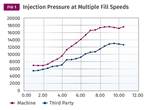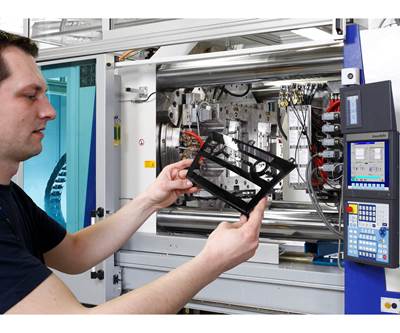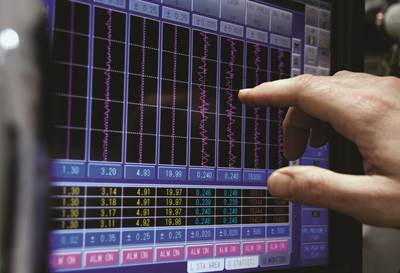Understanding—and Using—Decompression to Your Advantage
Decompression—aka suckback—is a very important setting on an injection molding machine. On today’s machines, molders typically get the option to set decompression before and after screw rotation/recovery. Are they using this feature to their advantage?
It is important to understand how decompression can affect overall shot size. Those who say that if you increase decompression you increase the volume of plastic in front of the screw are technically correct, but that isn’t due to plastics dropping into the feed throat while the screw pulls back.
It also depends on at what point in the recovery process the decompression is added. To understand how decompression affects shot size, we need to understand how a reciprocating screw works. Plastic pellets enter the feed throat through the material hopper or loader. When the screw begins to turn, its flights force the plastic pellets through the screw’s three distinct zones until the material makes its way to the front of the screw, hopefully at the desired melt consistency and melt temperature.
As the melt pushes through the non-return valve of the screw tip, plastic pressure builds up in front of the screw. This plastic pressure is what causes the screw to move backwards to achieve the desired shot size. Basically, if the screw is not turning, plastic cannot make its way in front of the screw. But when a screw decompresses, it is not supposed to turn—it pulls back until it reaches the desired setpoint.
Now, here’s the catch: if I decompress the screw before screw rotation begins, I create space between the screw tip and the cushion. As my screw rotates, it doesn’t immediately start retracting; it is unable to. The space that was created with the pre-rotate decompression, delays the build-up of plastic pressure in front of the screw until that space has been filled with plastic. The screw is working as an extruder, extruding material until plastic pressure builds and starts forcing the screw to retract. So decompression before screw rotation can increase the volume of material in my shot.
Does post-rotation decompression have a similar effect on our shot size? This is a question we need analyze a bit because I think that while many processors see the effect, they misunderstand what can occur. Remember, the screw must rotate for the volume of plastic to increase in front of the screw. Sucking the screw back linearly without rotation doesn’t add additional plastic to your shot size, and since this is done post-rotation, we don’t have the extruder effect from above. It does however increase the distance that the screw will need to travel to hit your transfer point and may have introduced air into the barrel. If this air doesn’t make its way out of the barrel, it can essentially help push more of your shot volume into the mold. So even though the volume of material in front of the screw didn’t change, more of that shot volume can be forced into the mold.
Decompression can do a lot to stabilize our process and increase the longevity of our molds. When I first started in the industry, decompression, mostly called suckback at the time, was almost a dirty word. Everyone was preaching that this setting only adds air to your process, it causes splay and is a Band-Aid for things like wet material. Frankly, we did use it as a Band-Aid most of the time, but that’s only because we didn’t really understand the positives.
Decompression can be used to reduce the pressure inside a hot runner before closing the valve gates and thereby increase the life span of those valve pins. It results in less wear and tear because the valves don’t have to fight as many opposing forces. Decompression can also help your check ring or ball valve to close and greatly improve the consistency of your cushion. In fact, many have adopted the procedure of setting post decompression to slightly higher than the throw of the check ring—I count myself among these people.
Understanding the Why
I believe it is important to try to understand as much about each setting on an injection molding machine as possible and how it can affect your process, for better or for worse. Being able to guess that increasing decompression will flash a mold without understanding the why isn’t a good thing. Not understanding the why causes us to turn things like decompression into a dirty word. Not understanding the why can cause us to miss out on a tool that can help improve our processes and help our molds last longer. If we understand how a process setting actually works, we can use it to our advantage and also predict how it will affect our process outputs. Since the injection molding process is a connected process, it is critical to know what a setting does so we know what it can affect.
About the Author: Robert Gattshall has more than 22 years’ experience in the injection molding industry and holds multiple certifications in Scientific Injection Molding and the tools of Lean Six Sigma. He has contributed articles for Plastics Technology and other magazines on multiple topics, such as scientific process development, process monitoring and the effects of variation. Gattshall has developed several “Best in Class” Poka Yoke systems with third-party production and process monitoring such as Intouch Production Monitoring and RJG. He has held multiple management and engineering positions throughout the industry in automotive, medical, electrical and packaging production. Gattshall is also a member of the Plastics Industry Association’s Public Policy Committee. In January 2018, he joined the IPL Plastics team as process engineering manager. Contact: (262) 909-5648; rgattshall@gmail.com.
Related Content
The Effects of Stress on Polymers
Previously we have discussed the effects of temperature and time on the long-term behavior of polymers. Now let's take a look at stress.
Read MoreThe Fundamentals of Polyethylene – Part 2: Density and Molecular Weight
PE properties can be adjusted either by changing the molecular weight or by altering the density. While this increases the possible combinations of properties, it also requires that the specification for the material be precise.
Read MoreInjection Molding: Focus on these Seven Areas to Set a Preventive Maintenance Schedule
Performing fundamental maintenance inspections frequently assures press longevity and process stability. Here’s a checklist to help you stay on top of seven key systems.
Read MoreWhere and How to Vent Injection Molds: Part 3
Questioning several “rules of thumb” about venting injection molds.
Read MoreRead Next
The 'Butterfly Effect' in Injection Molding—A Connected Process
In injection molding, a seemingly minor change in a setpoint can have a significant impact on part quality and process robustness and repeatability. That’s why Scientific Molding focuses on process outputs, not setpoints.
Read MoreINJECTION MOLDING: Scientific Molding Gone Wrong
Sometimes molders get trained in Scientific Molding only to revert to their old way of doing things as soon problems pop up.
Read MoreInjection Molding: Is There a ‘Most-Important’ Process Parameter?
A case can be made for multiple variables—fill balance, fill time, injection pressure, cavity pressure—as most important. But there is something else altogether that is essential to successful injection molding.
Read More





















